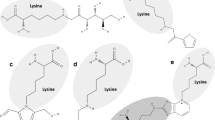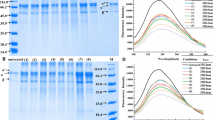Abstract
Dietary advanced glycation end products (AGEs) are involved in the pathogenesis of diabetic complications, atherosclerosis, and kidney disease. Formation of Nε-(carboxymethyl)lysine (CML), a well-known AGEs, was evaluated from the reaction of casein from bovine milk with different reducing sugars (glucose, tagatose, and xylose) at various sugar concentrations and heating temperatures (75 and 120 °C) used in food processing to determine the best sweetener to be used in dairy products. The concentration of CML was measured using an enzyme-linked immunosorbent assay. Additionally, SDS-PAGE was carried out to observe the changes in the molecular weight of casein. The results reveal that tagatose leads to a lower CML concentration at 75 °C than glucose or xylose, whereas no significant differences are observed at 120 °C. We conclude that it would be more appropriate to use tagatose rather than glucose or xylose as a sweetener, considering the AGEs contents in heat-treated dairy products.


Similar content being viewed by others
References
Charissou A, Ait-Ameur L, Birlouez-Aragon I. Kinetics of formation of three indicators of the Maillard reaction in model cookies: influence of baking temperature and type of sugar. J. Agric. Food Chem. 55: 4532-4539 (2007)
Delidovich I, Palkovits R. Catalytic isomerization of biomass-derived aldoses: a review. ChemSusChem. 9: 547-561 (2016)
Guerrero-Wyss M, Duran Aguero S, Angarita Davila L. d-tagatose is a promising sweetener to control glycaemia: a new functional food. BioMed. Res. Int. 2018: 8718053 (2018)
Hellwig M, Henle T. Baking, ageing, diabetes: a short history of the Maillard reaction. Angew Chem. Int. Ed. Engl. 53: 10316-10329 (2014)
Hull GLJ, Woodside JV, Ames JM, Cuskelly GJ. Nε-(carboxymethyl)lysine content of foods commonly consumed in a Western style diet. Food Chem. 131: 170-174 (2012)
Kang H, Uddin MA, Lee C, Kim K-H, Nguyen TL, Lee W, Li Y, Wang C, Woo HY, Kim BJ. Determining the role of polymer molecular weight for high-performance all-polymer solar cells: its effect on polymer aggregation and phase separation. J. Am. Chem. Soc. 137: 2359-2365 (2015)
Kellow NJ, Savige GS. Dietary advanced glycation end-product restriction for the attenuation of insulin resistance, oxidative stress and endothelial dysfunction: a systematic review. Eur. J. Clin. Nutr. 67: 239-248 (2013)
Lima M, Assar SH, Ames JM. Formation of Nε-(carboxymethyl)lysine and loss of lysine in casein glucose − fatty acid model systems. J. Agric. Food Chem. 58: 1954-1958 (2010)
Lund MN, Ray CA. Control of Maillard reactions in foods: strategies and chemical mechanisms. J. Agric. Food Chem. 65: 4537-4552 (2017)
Nguyen HT, van der Fels-Klerx HJ, van Boekel MAJS. Kinetics of Nε-(carboxymethyl)lysine formation in aqueous model systems of sugars and casein. Food Chem. 192: 125-133 (2016)
Oh M-J, Kim Y, Lee SH, Lee K-W, Park H-Y. Prediction of CML contents in the Maillard reaction products for casein–monosaccharides model. Food Chem. 267: 271-276 (2018)
Poulsen MW, Hedegaard RV, Andersen JM, de Courten B, Bugel S, Nielsen J, Skibsted LH, Dragsted LO. Advanced glycation endproducts in food and their effects on health. Food Chem. Toxicol. 60: 10-37 (2013)
Rippe JM, Angelopoulos TJ. Sugars, obesity, and cardiovascular disease: results from recent randomized control trials. Eur. J. Nutr. 55: 45-53 (2016)
Shaw JN, Baynes JW, Thorpe SR. N epsilon-(carboxymethyl)lysine (CML) as a biomarker of oxidative stress in long-lived tissue proteins. Methods Mol. Biol. 186: 129-137 (2002)
Swithers SE, Shearer J. Obesity: Sweetener associated with increased adiposity in young adults. Nat. Rev. Endocrinol. 13: 443-444 (2017)
Takeuchi M, Takino J, Furuno S, Shirai H, Kawakami M, Muramatsu M, Kobayashi Y, Yamagishi S. Assessment of the concentrations of various advanced glycation end-products in beverages and foods that are commonly consumed in Japan. PLoS One. 10: e0118652 (2015)
Uribarri J, del Castillo MD, de la Maza MP, Filip R, Gugliucci A, Luevano-Contreras C, Macias-Cervantes MH, Markowicz Bastos DH, Medrano A, Menini T, Portero-Otin M, Rojas A, Sampaio GR, Wrobel K, Garay-Sevilla ME. Dietary advanced glycation end products and their role in health and disease. Adv. Nutr. 6: 461-473 (2015)
Uribarri J, Woodruff S, Goodman S, Cai W, Chen X, Pyzik R, Yong A, Striker GE, Vlassara H. Advanced glycation end products in foods and a practical guide to their reduction in the diet. J. Am. Diet. Assoc. 110: 911-916 e912 (2010)
Vlassara H, Uribarri J. Advanced glycation end products (AGE) and diabetes: cause, effect, or both? Curr. Diab. Rep. 14: 453 (2014)
Acknowledgements
This research was supported by Main Research Program (E0164402-03) of the Korea Food Research Institute (KFRI) funded by the Ministry of Science and ICT.
Author information
Authors and Affiliations
Corresponding author
Ethics declarations
Conflict of interest
The authors declare that they have no conflict of interest.
Additional information
Publisher's Note
Springer Nature remains neutral with regard to jurisdictional claims in published maps and institutional affiliations.
Rights and permissions
About this article
Cite this article
Park, HY., Oh, MJ., Park, Y. et al. Nε-(carboxymethyl)lysine formation from the Maillard reaction of casein and different reducing sugars. Food Sci Biotechnol 29, 487–491 (2020). https://doi.org/10.1007/s10068-019-00689-3
Received:
Revised:
Accepted:
Published:
Issue Date:
DOI: https://doi.org/10.1007/s10068-019-00689-3




